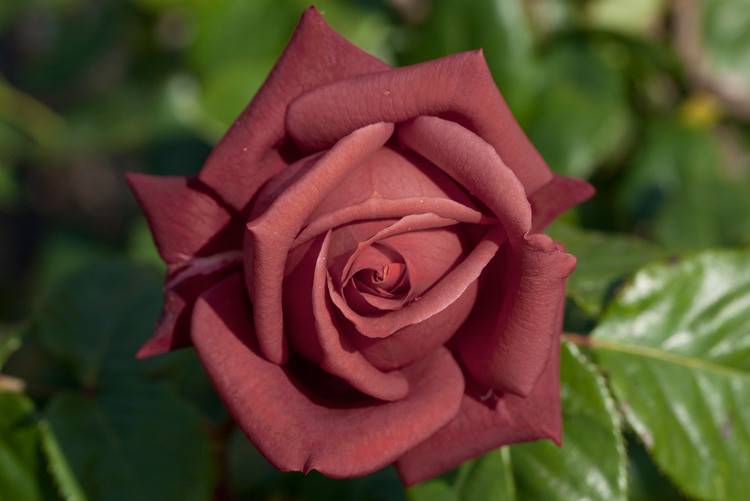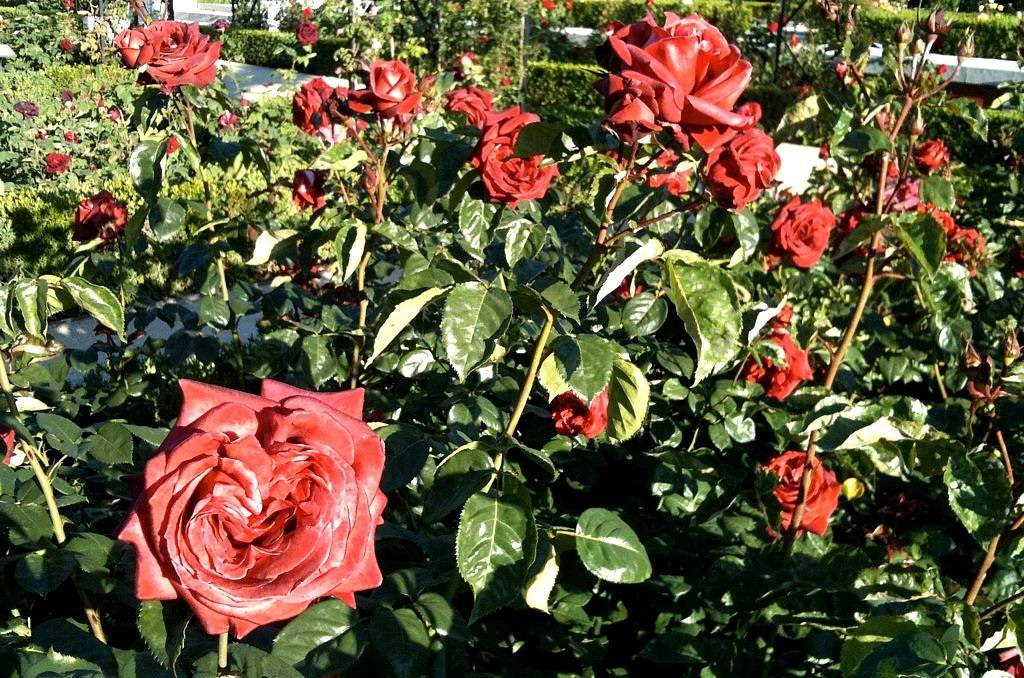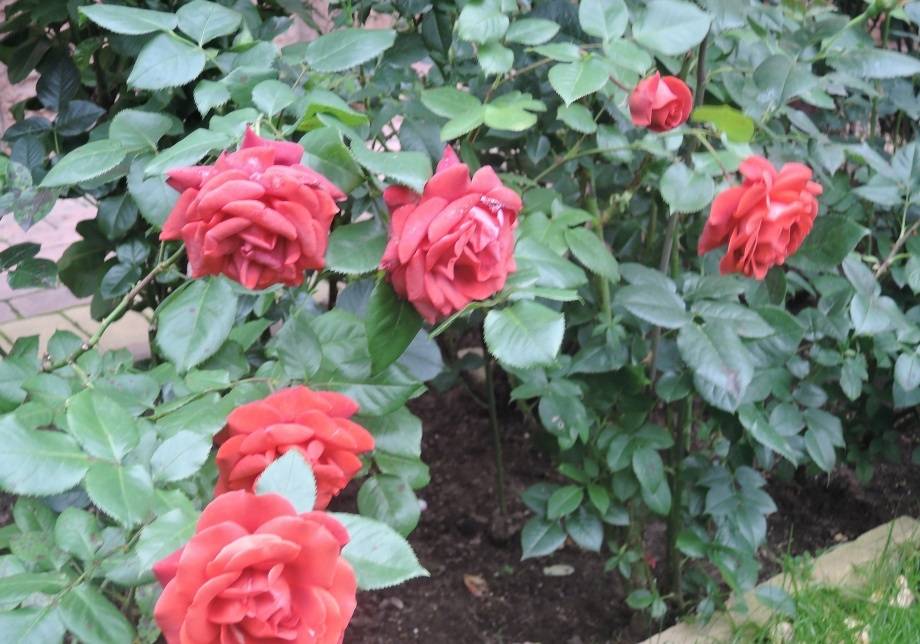Rose Terracotta (Terracotta) - description of the hybrid tea variety
Content:
Large dark red flowers decorate the garden like a king. Due to its regal appearance, the Terracotta rose is considered the queen of flowers.
Rose Terracotta - what is this variety
Terracotta is a rose belonging to the Grandiflora group. To create this group of flowers, breeders crossed Floribunda and hybrid tea varieties. The Terracotta variety has other names: Chocolate Prince, Chocolate Prince, SIMchoca, SIMchoka.
The hybrid tea rose Terracotta is famous for its active flowering, which makes it related to the floribunda species. But many experts classify these flowers as grandiflora. This flower is also referred to the group of scrubs - semi-growing shrubs. Rose scrub Terracotta has a developed root system and strong shoots.
Rose Grandiflora Terracotta appeared in 1994. It was bred by French breeders from the Meilland company. Now this flower is in great demand in landscape design and floristry.
Brief description and characteristics
Terracotta combines the qualities of hybrid tea and floribunda. In its description and characteristics, the features of each of these two types are distinguished.
The rose bush blooms very luxuriantly and profusely. It grows to a height of 70–80 cm. The volume of the bush is about 650 cm. Powerful, solid stems hold large flowers, collected in racemose inflorescences. The thorns are not very long. The leaves are colored deep green, sometimes with lighter shades. This variety is odorless.
This plant is resistant to many diseases, including fungal infections. The variety has excellent immunity to black spot and powdery mildew. It is quite hardy, frost-resistant, but does not tolerate rain well.
Advantages and disadvantages of the variety
Terracotta has many advantages over other varieties, as well as many other colors that are used in landscaping.
Advantages:
- large flower heads;
- abundant and lush bloom;
- resistant immunity to most plant diseases.
Experienced growers do not find flaws in this variety.
Use in landscape design
Terracotta makes up luxurious bouquets. These flowers are actively used in landscape design; they are grown in gardens, flower beds, flower beds and lawns. It is suitable for any landscape style in a wide variety of compositions. The terracotta beauty will look great with roses of other colors, especially contrasting ones: white, yellow or light pink.
Growing a flower
Even an inexperienced florist can grow Terracotta. This flower must be planted outdoors and then properly cared for.
To plant Terracotta, you need some seedlings. They can be purchased at the store or grown from cuttings cut from an adult shrub. Choose healthy seedlings with strong and well-developed roots.
It is necessary to plant Terracotta in April or early May. In regions with a warm southern climate, this flower can be planted in early autumn, but so that it takes root and takes root before the first frost, otherwise the rose will die.
Seat selection
Terracotta loves an abundance of light, so you need to choose a well-lit place for it. Nevertheless, it should be slightly shaded so that the bright sun does not burn the leaves at noon and in the afternoon. The place should be well ventilated so that cold humid air does not stagnate in it.
How to prepare the soil and flower for planting
Roses grow only on light fertile soils, so the soil must be fertilized before planting. For Terracotta, soil with a low degree of acidity is ideal, for example, a soil type such as light loam. The pH should be between 5.6 and 6.5. It is advisable to choose a place for planting where groundwater lies at a depth of at least 1 m.
How to prepare the soil:
- Dig a hole 60 cm deep.
- Put drainage on the bottom - crushed stone, expanded clay, small stones, gravel.
- Add fertilizer. The layer thickness should be at least 10 cm. You can feed the soil with manure or compost.
- Then add another 10 cm of soil.
- The seedling must be placed in a root growth stimulant solution 24 hours before planting in open ground. It is advisable to use the drug heteroauxin.
Planting procedure step by step
All the requirements for planting a flower must be properly observed. If everything is done correctly, then after a while the grower will be able to enjoy the beauty of roses.
How to plant Terracotta:
- After the seedling has stood for 1 day in a solution of heteroauxin (root growth stimulant), you need to carefully examine its root system.
- Damaged, weak and too long roots are cut with a disinfected pruner.
- The seedling is placed in a hole, the roots are spread and covered with earth. The root collar should go underground to a depth of 3 cm.
- A young rose bush is watered abundantly with warm, settled water.
- The land near the roots of the bush must be mulched with peat or pine bark.
Plant care
Care for a beautiful rose must be very careful. This regal flower requires careful attention to itself, so care should be regular.
Watering rules and humidity
During dry hot weather, Terracotta should be watered 2 times a week, using 20 liters of water each time. On rainy days, the flower does not need to be watered. Water for irrigation can be kept in a barrel or any other large container. In September and until next spring, the rose can not be watered, because moisture from the ground evaporates much more slowly.
Top dressing and soil quality
In the spring months, Terracotta is fed with nitrogenous fertilizers. In summer, it needs to be fertilized with potash and phosphorus fertilizers.
Pruning and replanting
The main, most important pruning of Terracotta is carried out in the spring immediately after the removal of the winter shelter. It is necessary to give the bush a shape and stimulate the growth of young shoots.During the summer, when the rose is blooming, faded buds and petals must be removed from its stems. In the fall, weak, damaged, diseased and too long branches are cut off from the bush. Before sheltering for the winter, the bush also needs to be cut a little.
Several types of pruning are performed:
- lightweight. Faded buds and old shoots are removed, carried out in summer and autumn;
- moderate. For early and beautiful flowering, the rose is cut in the spring, leaving 5–6 buds;
- strong. To rejuvenate the bush, it is carried out in the spring, leaving 2-3 buds.
It is necessary to replant the plant only if the soil turned out to be infertile, too wet, or if the rules of care were violated. In overfed and overfed soil, the rose does not bloom well, so you will have to transplant it to a new site, observing all the rules of planting and care.
Features of wintering a flower
In late autumn or early winter, when the air temperature drops to -7 ° C, the terracotta rose must be covered for the winter.
How to make a winter shelter:
- The rose bush is cut and covered with earth from all sides so that it rises 5-10 cm above the ground.
- Then it is covered with spruce branches (spruce branches).
- A metal frame is installed over the bush and covered with insulation, and from above it is also covered with plastic wrap.
- Small holes should be left on the sides so that air can pass through them.
Blooming rose
Luxurious rose bloom is the most important thing for a grower. He must know when Terracotta will bloom and what needs to be done for this.
A period of activity and rest
Terracotta blooms in June and blooms until mid-September.
Care during and after flowering
During the period of active flowering, the rose needs good care. It is necessary to constantly remove faded flowers and wilted petals, regularly weed the flower bed and loosen the ground. The life of a flower depends on compliance with the rules of watering and feeding.
What to do if it does not bloom
The rose will not bloom if it is planted in heavy, infertile soil or in a dark area where there is no sun. In this case, the flower needs to be transplanted to a more suitable place.
Due to overfeeding with nitrogenous fertilizers, the rose will not bloom, but will grow young shoots. Therefore, you need to follow the rules of feeding.
Flower propagation
The Terracotta rose can only be propagated vegetatively - by cuttings or layering. These two methods are suitable for almost all types of roses.
The most suitable time of the year for cuttings is autumn before the onset of frost. You can propagate a rose by layering in spring and summer.
Propagation by cuttings:
- During autumn pruning, a ripe shoot is cut off from the bush.
- This shoot is cut into several cuttings, each of which should have 3-5 strong healthy buds.
- Leaves are cut off from the bottom of the cutting.
- They plant the stalk in the ground.
Reproduction by layering:
- One of the shoots is covered with a cut-off plastic bottle.
- With the sharp edges of the bottle, peel the bark from the stem and apply a stimulant for root growth to this place.
- They put the bottle on the shoot again, pour the soil and fix the structure.
- When the root sprouts, the cut is cut off and transplanted to another flower bed.
Diseases, pests and ways to control them
This variety has a strong immune system that protects flowers from many diseases. What fungal diseases and pests threaten Terracotta:
- rust. Cut off and burn diseased leaves.Treat the bush with Bordeaux liquid (2% solution), a decoction of wormwood or nettle, as well as a solution of soap and copper sulfate;
- gray rot. Remove infected places. For prevention, feed the rose with manganese fertilizers on rainy days;
- spider mite. After removing diseased leaves, treat the bush with any insecticides three times with an interval of 5–7 days;
- rose (green) aphid. Treat with soapy water, decoction of garlic, tobacco or pepper, as well as fufanon, actellic or aktara preparations. Several treatments are needed with an interval of three days;
- slobbering penny. Remove lumps of foam with a damp cloth, pour water over the bush from a hose, then treat with any insecticide;
- leaflet. A decoction of onions, garlic or tobacco will help against it. The caterpillars have to be assembled by hand;
- shield. Remove parasites with a damp cotton swab, treat with fufanon or actara;
- bear. Plow the soil in early spring and autumn, plant marigolds nearby. On dry days, water the flower with a solution of chicken droppings.
For prevention, it is necessary to regularly treat the flower with pest control agents.
Lovely Terracotta needs excellent maintenance. It needs to be watered, fed, weeded, cut off. With her lush flowering, she will reward the grower a hundredfold.



























